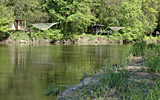Czech Republic
Landscape, Climate and Water Flow
The Czech Republic is largely a highland country formed in the northwest by the Bohemian Massif, in the east by a bend of the Beskyds and Carpathian Mountains and in the south by plateaus and the Pannonian Plain. Approximately 7 % of the Morava River Basin is formed by mountains, 35 % by highlands, 51 % by plains, plateaus and valleys, and lowlands cover 7 % of the area. The average annual precipitation in the Czech part of the Morava River Basin is 635 mm, while in the mountainous areas it is higher – up to 1,200 mm per year. The climate of the Morava River Basin is continental, with the lowest temperatures occurring in January and the highest in July.
Did you know?
The national nature reserve Lednicke rybniky, one of the oldest pond systems in the Morava Basin, is a bird sanctuary and an important transboundary wetland. In the first half of the 19th century the pond banks were altered, giving birth to the unique countryside park. This area of five large ponds, preserved since 1953 as breeding grounds, also serves as landing and crossroads areas for water birds in their yearly flights.
Natural highlights include:
The most important protected area in the Czech part of the basin is the bilateral Podyji-Thayatal National Park. It represents an exceptionally well-preserved pattern of river valley countryside in the upland part of Europe. Together with the Austrian part they form a unique bilateral area of European importance. Though it is the smallest national park in the Czech Republic, the Dyje canyon creates a unique river phenomenon with deep meanders and high diversity of animal and plant species, including 18 kinds of orchids.
Human Uses
Agricultural land covers about 60 % of the area, followed by forests at 32 % and urbanised areas at 1.5 %. The Morava River Basin in the Czech Republic has a high population density, 137 inhabitants per square kilometre. The largest cities in the area are the industrial and trade fair town of Brno (390,000 inhabitants) and the historic town of Olomouc (160,000 inhabitants), both roughly situated in the central part of the basin on the confluence of rivers.
Pollution
Due to the highly developed industry and agriculture in the Czech part of the Morava River basin, rivers in the region serve as recipients of both urban and industrial waste water effluents. They also transport diffuse pollution loads, containing organic matters and nutrients originating chiefly in agriculture. Together with low flows in rivers, this poses higher requirements on the quality of discharged waste water, and the whole basin has been declared as a sensitive area.
In the Czech part of the Danube River Basin there are about 1,800 municipalities and approximately 79 % of inhabitants are connected to wastewater treatment plants. Agriculture is the biggest source of nutrients and contributes more than 65 % of the total load of nitrogen emissions into surface waters. Agriculture also contributes 30 % of the total rate for phosphorus. Several important measures have been implemented to improve the situation: rehabilitating watercourses, increasing protection of existing waters and wetlands and ending unfavourable agricultural practices.
For detailed information on the above, download the fact sheet below.
Disclaimer
The information contained in the ICPDR website is intended to enhance public access to information about the ICPDR and the Danube River. The information is correct to the best of the knowledge of the ICPDR Secretariat. If errors are brought to our attention we will try to correct them.
The ICPDR, expert group members, nor other parties involved in preparation of information contained on this website cannot, however, be held responsible for the correctness and validity of the data and information provided, nor accept responsibility or liability for damages or losses arising directly or indirectly from the use of the information conveyed therein.
Only those documents clearly marked ICPDR documents reflect the position of the ICPDR.
Any links to other websites are provided for your convenience only. The ICPDR does not accept any responsibility for the accuracy, availability, or appropriateness to the user's purposes, of any information or services on any other website.
When using the information and material provided on this website, credit should be given to the ICPDR.

